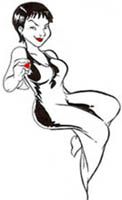Sunday, February 06, 2005
Poetry 101: lesson 3
At last, we’ve gotten to the final dissection of my statement:Poetry is the unique expression, commonly in verse form, of universal experience.‘Unique expression’ is the most critical part, baby.
Now, as we discussed in lesson 1, you want your poem to be something that readers can identify with. But what you want to do, ideally, is to present this universal experience in a fresh way. You can be saying something as banal as “Love is grand” but if you actually just say it like that: “Love is grand. How I love love!”, then banal is exactly what your poem is. You need to shake it up some, revise the paradigm, razzle-dazzle ‘em—because a zillion people have written about love before you, and probably done it better.
I’m not saying that you need to say something new and earth-shaking about love (or whatever your topic is)—for one thing, there may not even be anything new and earth-shaking left to say. But take a look at how poet Ruey de Vera puts it (I’m paraphrasing, okay?): “Let us watch mountains grow together.” Essentially, all he’s saying is “Let’s be together forever”, but how elegantly he puts it! The imagery perfectly expresses an avowal of enduring commitment over time.
Another poet, Nikki Giovanni, tells us that a person in love feels “like a contented cow, chewing cud”. It isn’t what most people would perceive as a poetic metaphor, but see how it makes you view the experience of love in a whole new light. This is exactly what poetry should do: it awakens you, as a reader, to a realization of something you always knew but were never consciously aware of.
Therefore, in poetry—more than with any other form of writing—you need to show, not tell; to illustrate the point, not to explain it. Imagery is important, metaphor is important—as I’ve said before and am saying again, you don’t just say what you’re thinking, put it in stanzas, and call it a poem. You build a little mental landscape, you create a tiny emotional dwelling, you isolate a moment of perfect clarity. And you use imagery and metaphor and alliteration and a million other aspects of craft to do it, because dammit, that’s what makes poetry, not “poitry”. It’s not so much about the writing as it is about the seeing—and making your readers see it with you.
As with all my little online ruminations, take this with a sack of salt: I’m not really an authority, and I could be wrong. But it’s poetry, man—it means something different to everyone, and what it means to you is exactly what it means... Except, of course, when I’m right and you’re wrong.
Heh.










